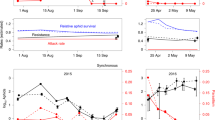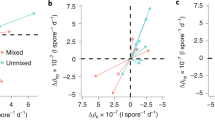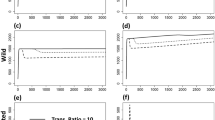Abstract
One of the central challenges of evolutionary biology is to understand how coevolution organizes biodiversity over complex geographic landscapes. Most species are collections of genetically differentiated populations, and these populations have the potential to become adapted to their local environments in different ways. The geographic mosaic theory of coevolution incorporates this idea by proposing that spatial variation in natural selection and gene flow across a landscape can shape local coevolutionary dynamics1,2,3,4,5,6,7. These effects may be particularly strong when populations differ across productivity gradients, where gene flow will often be asymmetric among populations8. Conclusive empirical tests of this theory have been particularly difficult to perform because they require knowledge of patterns of gene flow, historical population relationships and local selection pressures2. We have tested these predictions empirically using a model community of bacteria and bacteriophage (viral parasitoids of bacteria). We show that gene flow across a spatially structured landscape alters coevolution of parasitoids and their hosts and that the resulting patterns of adaptation can fluctuate in both space and time.
This is a preview of subscription content, access via your institution
Access options
Subscribe to this journal
Receive 51 print issues and online access
$199.00 per year
only $3.90 per issue
Buy this article
- Purchase on Springer Link
- Instant access to full article PDF
Prices may be subject to local taxes which are calculated during checkout



Similar content being viewed by others
References
Thompson, J. N. The Coevolutionary Process (Univ. of Chicago Press, Chicago, 1994)
Brodie, E. D. Jr, Ridenhour, B. J. & Brodie, E. D. III The evolutionary response of predators to dangerous prey: hotspots and coldspots in the geographic mosaic of coevolution between garter snakes and newts. Evolution 56, 2067–2082 (2002)
Burdon, J. J. & Thrall, P. H. Spatial and temporal patterns in coevolving plant and pathogen associations. Am. Nat. 153, S15–S33 (2002)
Zangerl, A. R. & Berenbaum, M. R. Phenotype matching in wild parsnip and parsnip webworms: causes and consequences. Evolution 57, 806–815 (2003)
Thompson, J. N. & Cunningham, B. M. Geographic structure and dynamics of coevolutionary selection. Nature 417, 735–738 (2002)
Benkman, C. W., Parchman, T. L., Favis, A. & Siepielski, A. M. Reciprocal selection causes a coevolutionary arms race between crossbills and lodgepole pine. Am. Nat. 162, 182–194 (2003)
Nuismer, S. L., Thompson, J. N. & Gomulkiewicz, R. Gene flow and geographically structured coevolution. Proc. R. Soc. Lond. B 266, 605–609 (1999)
Hochberg, M. & van Baalen, M. Antagonistic coevolution over productivity gradients. Am. Nat. 152, 620–634 (1998)
Chao, L., Levin, B. R. & Stewart, F. M. A complex community in a simple habitat: an experimental study with bacteria and phage. Ecology 58, 369–378 (1977)
Lenski, R. E. & Levin, B. R. Constraints on the coevolution of bacteria and virulent phage: a model, some experiments, and predictions for natural communities. Am. Nat. 125, 585–602 (1985)
Shrag, S. J. & Mittler, J. E. Host–parasite coexistence: the role of spatial refuges in stabilizing bacteria-phage interactions. Am. Nat. 148, 348–377 (1996)
Bohannan, B. J. M. & Lenski, R. E. The relative importance of competition and predation varies with productivity in a model system. Am. Nat. 156, 329–340 (2000)
Buckling, A. & Rainey, P. B. Antagonistic coevolution between a bacterium and a bacteriophage. Proc. R. Soc. Lond. B 269, 931–936 (2002)
Thompson, J. N. The evolution of species interactions. Science 284, 2116–2118 (1999)
Bohannan, B. J. M. & Lenski, R. E. The effect of resource enrichment on a chemostat community of bacteria and phage. Ecology 78, 2303–2315 (1997)
Gandon, S. Local adaptation and the geometry of host–parasite coevolution. Ecol. Lett. 5, 246–256 (2002)
Gandon, S. & Michalakis, Y. Local adaptation, evolutionary potential and host–parasite coevolution: interactions between migration, mutation, population size and generation time. J. Evol. Biol. 15, 451–462 (2002)
Gomulkiewicz, R., Thompson, J. N., Holt, R. D., Nuismer, S. L. & Hochberg, M. E. Hot spots, cold spots and the geographic mosaic theory of coevolution. Am. Nat. 156, 156–174 (2000)
Slatkin, M. Gene flow in natural populations. Annu. Rev. Ecol. Syst. 16, 393–430 (1985)
Futuyma, D. J. Evolutionary Biology, 3rd edn (Sinauer Associates Inc., Sunderland, 1998)
Gandon, S., Capowiez, Y., Dubios, Y., Michalakis, Y. & Olivieri, I. Local adaptation and gene-for-gene coevolution in a metapopulation model. Proc. R. Soc. Lond. B 263, 1003–1009 (1996)
Buckling, A., Wills, M. A. & Colegrave, N. Adaptation limits diversification of experimental bacterial populations. Science 302, 2107–2109 (2003)
Brockhurst, M. A., Morgan, A. D., Rainey, P. B. & Buckling, A. Population mixing accelerates coevolution. Ecol. Lett. 6, 975–979 (2003)
Bohannan, B. J. M. & Lenski, R. E. Effect of prey heterogeneity on the response of a model food chain to resource enrichment. Am. Nat. 153, 73–82 (1999)
Rice, W. R. Analyzing tables of statistical tests. Evolution 43, 223–225 (1989)
Acknowledgements
We thank B. Kerr, E. Danner and members of the Thompson and Bohannan laboratories for comments on previous drafts of this manuscript. We are grateful to P. Raimondi for assistance with data analysis.
Author information
Authors and Affiliations
Corresponding author
Ethics declarations
Competing interests
The authors declare that they have no competing financial interests.
Rights and permissions
About this article
Cite this article
Forde, S., Thompson, J. & Bohannan, B. Adaptation varies through space and time in a coevolving host–parasitoid interaction. Nature 431, 841–844 (2004). https://doi.org/10.1038/nature02906
Received:
Accepted:
Issue Date:
DOI: https://doi.org/10.1038/nature02906
This article is cited by
-
Phage mobility is a core determinant of phage–bacteria coexistence in biofilms
The ISME Journal (2018)
-
Dispersal network structure and infection mechanism shape diversity in a coevolutionary bacteria-phage system
The ISME Journal (2014)
-
The spatial distribution does not affect host–parasite coevolution in Rossomyrmex ants
Insectes Sociaux (2012)
-
Spatial heterogeneity, frequency-dependent selection and polymorphism in host-parasite interactions
BMC Evolutionary Biology (2011)
-
Weevils and camellias in a Darwin's race: model system for the study of eco‐evolutionary interactions between species
Ecological Research (2011)
Comments
By submitting a comment you agree to abide by our Terms and Community Guidelines. If you find something abusive or that does not comply with our terms or guidelines please flag it as inappropriate.



